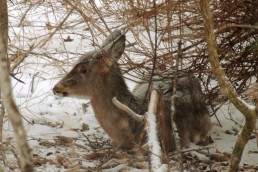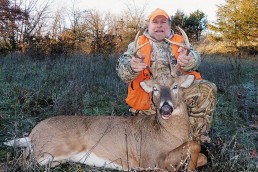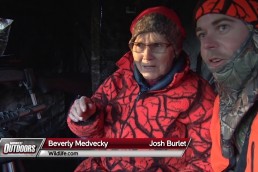Nordberg on Deer: Hunting Bedding Areas
SHARE THIS POST
Since 1990, my sons and I have taken several trophy-class dominant bucks from doe bedding areas midday during the primary breeding phase of the rut in November. I took one big 10-pointer while stand hunting alone, but all of the others were taken while using our notably deadly, small-group stand hunting method called “the gentle nudge.”
Unless the doe is in heat and it is accompanied by a dominant buck, stand hunting one-on-one near a doe bedding area midday is like watching paint dry—nothing moves. Moreover, to take a dominant buck at such a site requires an approach I’m not altogether fond of: getting there well before the doe and her entourage is due to arrive in the morning. This means you might as well skip morning hunting the day you try it so you can be properly in place crosswind within peekaboo range of the latest beds made by the doe and her young by 9 a.m. If I have to chose to hunt between hunting from first light to 9 a.m. near a doe feeding area and hunting from 9 a.m. to 3 or 4 o’clock in the afternoon near a doe bedding area, I’d be hard-pressed to settle for hunting at the bedding area. If a gentle nudge was planned, I’d be hard-pressed to not select the bedding area.
Bedding areas of adult does in forest areas are not difficult to identify. Beds of certain sizes are their principle identifying deer signs. Typically clearly outlined in deep grasses, fallen leaves or snow in mixed timber (or loose dirt in cornfields), beds of adult does are about 40 inches in length (whitetail beds are this large in northern states and northern Georgia only). Beds of accompanying yearling bucks are about the same length. Beds of accompanying yearling does are about two inches shorter and beds of accompanying fawns are three feet or less in length. Other identifying deer signs include plenty of off-trails hoof prints, fresh (most important) and old, three inches or less in length. Because whitetails typically empty their bowels upon rising from their beds, their bedding areas also have a lot of droppings 1/2 inch or less in length, fresh and shiny (most important) and dull (old) in appearance. Outlines of doe bedding areas are often very irregular and they are much larger than buck bedding areas.
Does and their young often lie in the same general areas day after day, but rarely in the same beds twice in a row. Maternal does logically attempt to keep predator-attracting fawn scents from becoming too intense at any one spot. The belief that spotted fawns are odorless is pure myth. Via airborne and trail scents, gray wolves discover and eat three-quarters of the spotted fawns born in my study area from May through October annually.
Are you enjoying this post?
You can be among the first to get the latest info on where to go, what to use and how to use it!
Stand hunting next to the bedding area if a doe is in heat and accompanied by a dominant buck can be plenty exciting. After an hour or so of repeatedly missing a chance to fire at a dominant buck chasing a yearling buck at top speed past my stand, I was finally rewarded with an easy opportunity for a short-range shot after the buck abruptly halted half-hidden by upraised roots of a fallen cedar tree. All I could see was the rear half of the buck. After an errant breeze carried my scent toward the buck, its tail slowly began to rise and fan out. Figuring it was about to bolt, I took aim at the location of the two major blood vessels (descending aorta and ascending vena cava) coursing horizontally beneath the spine between the tenderloins just forward of its hind quarters and fired (blood vessels I’d seen hundreds of times in 65 years of butchering Nordberg whitetails). As expected, massive internal bleeding stopped the buck only 30 yards away. Too heavy to drag alone, I had to enlist the aid of several neighboring hunters to help get that buck to camp a half-mile away.
Though I have occasionally hunted near bedding areas of dominant bucks, it’s always an enormously challenging undertaking. I have never tried it while breeding was in progress because dominant bucks rarely, if ever, return to their bedding areas while does in in their breeding ranges are in heat. At other times, as I eventually learned, the hard way, it is not only very difficult to avoid being detected by a bedded mature buck while approaching or departing from its bedding area, but once detected, such a buck will very likely abandon its entire range until the hunting season is over. I’ve known bucks that have never returned after they’ve spotted me. After I convinced everyone in camp to stay well away from known bedding areas of mature bucks, it soon became obvious that when older bucks have secure bedding areas during hunting seasons, they are far less likely to abandon their ranges. This precaution and stand hunting combine to keep trophy-class bucks from abandoning our hunting area right up through the last day of a hunting season. Not hunting near buck bedding areas even during the final day or two of our hunts also insures all bucks less than 6 1/2 years of age that survive one hunting season will be back in their usual haunts during the following hunting season (except, perhaps, following a severe winter). Very few wild bucks survive their seventh winter. In 70 years of whitetail hunting, bucks only for 45, I am the only hunter I know of that has taken a 7-1/2-year-old whitetail buck.
Generally, your end-of-season buck hunting success and your overall buck hunting success will be best if you stick to hunting favorite feeding areas of does rather than bedding areas of either sex.
The above is an excerpt from Dr. Nordberg’s soon-to-be-published 10th edition of “Whitetail Hunters Almanac.” For more information visit drnordbergondeerhunting.com.
MWO
SHARE THIS POST
Did you enjoy this post?
You can be among the first to get the latest info on where to go, what to use and how to use it!
Dr. Ken Nordberg
Based on his 55 years of field research, Dr. Ken Nordberg has written more than 800 magazine articles, 12 books on whitetails—including the famous Whitetail Hunter’s Almanac series—five books on black bear hunting and produced Buck and Bear Hunting School videos. You may peruse his encyclopedic website with whitetail hunting tips: drnordbergondeerhunting.com, his blog: drnordbergondeerhunting.wordpress.com, or social media pages.



